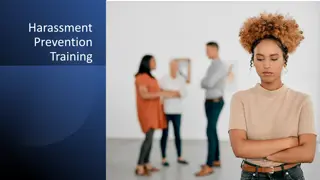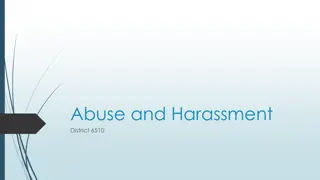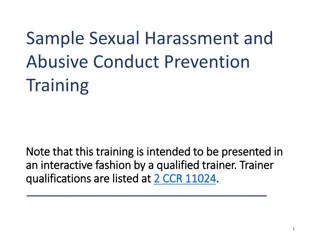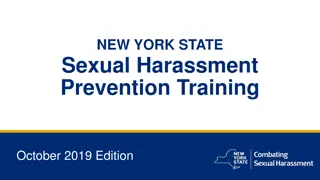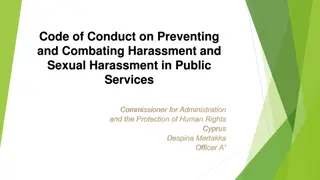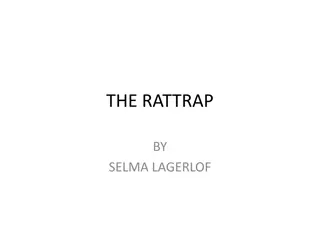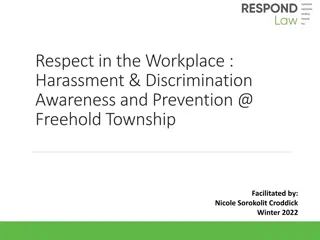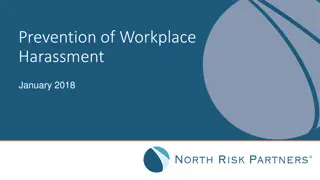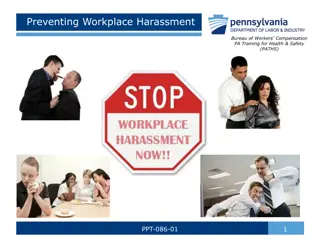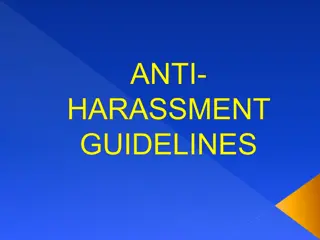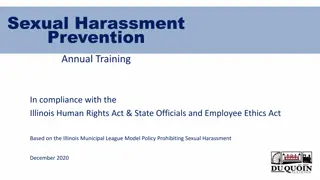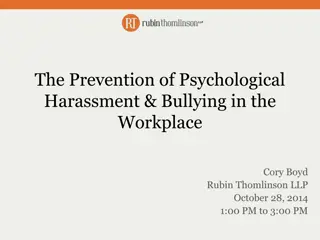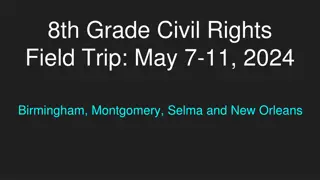Harassment Awareness Training at Wallace Community College Selma
This content provides information on harassment awareness training at Wallace Community College Selma, including defining harassment, identifying types of harassing behavior, understanding management responsibilities, and how to respond to harassment situations. It emphasizes the importance of recognizing and addressing harassment in the workplace and academic environments.
Download Presentation

Please find below an Image/Link to download the presentation.
The content on the website is provided AS IS for your information and personal use only. It may not be sold, licensed, or shared on other websites without obtaining consent from the author. Download presentation by click this link. If you encounter any issues during the download, it is possible that the publisher has removed the file from their server.
E N D
Presentation Transcript
Wallace Community College Selma Wallace Community College Selma 2020 Annual 2020 Annual HARASSMENT AWARENESS TRAINING HARASSMENT AWARENESS TRAINING Mrs. Colleen Dixon Human Resources Coordinator Wallace Community College-Selma Since 1966
Agenda Define Harassment Alabama Community College System (ACCS) Definition of Sexual Harassment Identify when conduct can be defined as Harassment as defined in the ACCS Manual Discuss the Importance of Perception Identify the Types of Harassing Behavior Review WCCS Expectations Regarding Harassment Address how to respond to the Harasser Management Responsibilities Summary Quiz Wallace Community College-Selma Since 1966
Objectives Identify examples of harassment in the workplace and classroom environment Recognize how a person s perceptions can be different from the intention of the perceived harasser Identify the most common type of Harassment Pinpoint when the behavior violates the ACCS Policy Guide s definition of Harassment Understand how to respond to a situation, document, and report Harassment Wallace Community College-Selma Since 1966
Definition of Harassment Harassment is unwanted and unwelcomed behavior that creates an intimidating, hostile, or offensive work (or academic) environment. Wallace Community College-Selma Since 1966
ACCS Definition of Sexual Harassment Sexual harassment is a form of sex discrimination which is illegal under Title VII of the Civil Rights Act of 1964 for employees and under Title IX of the Education Amendments of 1972 for students. Sexual harassment does not refer to occasional compliments; it refers to behavior of a sexual nature Sexual harassment may involve which interferes with the work or education of its victims and their co-workers or fellow students. The behavior of a person of either sex against a person of the opposite sex or the same sex, and occurs when such behavior constitutes unwelcome sexual advances, unwelcome requests for sexual favors, or other unwelcome verbal or physical conduct of a sexual nature. Harassment of employees or students by non-employees is also a violation of this policy. All forms of harassment are a violation of ACCS policy and will not be ignored, tolerated or accepted. Wallace Community College-Selma Since 1966
When Harassing Conduct Violates WCCS Policy 1. The conduct must be unwelcomed, or unwelcomed and based on the victim s protected status. 2. Subjectively abusive to the person affected. 3. Objectively severe and pervasive enough to create a work environment that a reasonable person would find hostile or abusive. Wallace Community College-Selma Since 1966
What is Severe and Pervasive? 1. What was the frequency of the unwelcomed conduct? 2. What was the severity of the conduct? 3. Was the conduct physically threatening or humiliating? 4. Did the conduct unreasonably interfere with work (or academic) performance? *****These are all determined on a case-by-case basis***** Wallace Community College-Selma Since 1966
Perception Harassment is in the eye of the beholder. A person or persons should also be aware of how behaviors are taken by others on the outside, looking in. This can also lead to 3rd Party Harassment. It doesn t matter how the person intended the action to be taken, but how it was ultimately received. Wallace Community College-Selma Since 1966
Types of Harassment Wallace Community College-Selma Since 1966
Types of Harassment Quid Pro Quo (A favor or advantage granted or expected in return for something). Hostile Work (or Academic) Environment Bullying Physical Harassment Verbal Harassment Visual Harassment Social Media Wallace Community College-Selma Since 1966
Types of Harassment Quid Pro Quo Also known as This for That. When submission to or rejection of unwelcomed advances or conduct is used as the basis for an employment decision. Wallace Community College-Selma Since 1966
Types of Harassment Hostile Work (or Academic) Environment (1 of 2) Created when aggression or unwelcomed behavior unreasonably interferes with an individual s job (or academic) performance Creates an intimidating, hostile, or offensive work (and learning) environment, regardless of whether or not it leads to more money, job advancement, or academic success. Wallace Community College-Selma Since 1966
Types of Harassment Hostile Work (or Academic) Environment (2 of 2) Generally, a single or isolated incident is not enough to create a hostile work (or academic) environment. However, a single, or unusually severe incident of harassment may be sufficient to warrant a claim. Wallace Community College-Selma Since 1966
Types of Harassment Bullying (1 of 2) The deliberate, hurtful, repeated, mistreatment of personnel driven by a desire to control. Examples: 1) Constant and unfair criticism 2) Social bantering and teasing 3) Yelling, shouting and screaming 4) Behind the back insults and put downs 5) Hostile glares 6) Intimidating gestures Wallace Community College-Selma Since 1966
Types of Harassment Bullying (2 of 2) Threats of aggression or violence Monopolizing supplies & other resources Malicious gossiping Inappropriate e-mails, texts, social media updates Wallace Community College-Selma Since 1966
Types of Harassment Physical Harassment Horseplay can constitute harassment Touching, grabbing, pinching, rubbing, or any unwanted physical contact Impeding or blocking someone s movement No means No! Stop , means Stop! Wallace Community College-Selma Since 1966
Types of Harassment Verbal Harassment Inappropriate comments about an individual s body, appearance, or culture. Derogatory, explicit, or offensive comments (I.e.., Racially charged comments, gestures, or jokes) Repeated unwelcomed propositions or flirtations; Dirty jokes Veiled Threats Discussing sexual activities, or innuendos Profanity Wallace Community College-Selma Since 1966
Types of Harassment Visual Harassment Offensive or indecent gestures. Pictures, cartoons, or drawings displaying sexually suggestive (or racial insensitive) material. [E.g. Pornography; Black dolls hanging from a noose; White Supremacist Propaganda; Swastikas, etc.] Indecent exposure of person Wallace Community College-Selma Since 1966
Types of Harassment Social Media Technology can serve as a delivery method for harassment, sexual harassment, and bullying behaviors. Unlawful conduct such as Sexual Harassment is not limited to the physical workplace (or academic setting). Online harassment can occur during (or after) regular business hours. Virtual (or online) harassment is becoming a widespread issue & prohibited by WCCS and ACCS. Wallace Community College-Selma Since 1966
Workplace (or Academic) Environment Wallace Community College-Selma Since 1966
Workplace (or Academic Setting) Dating Why We Give In? Human Nature. What s the Harm? Complaints of Favoritism. Jealousy. Gossip. Workplace distractions. Spend significant time working together. Limited opportunities to meet other people. Appears as an inappropriate use of power. Wallace Community College-Selma Since 1966
Sexual Activity There s no appropriate sexual activity at work (or in the academic environment). Not just intercourse Examples include intimate touching, kissing, and physical contact in the workplace or Academic Environment All areas are off-limits (I.e., Gym, parking lots, restrooms, break rooms, etc.) Whom you re attached to, married to, or dating at WCCS doesn t matter. Wallace Community College-Selma Since 1966
Fairness (1 of 2) Recognize Individuals Based on Contribution & Academic Proficiency Promote all individuals fairly Allocate opportunities to individuals based on their potential, not on family or other connections (E.g., Fraternities, Sororities, political affiliations, etc.) Separate individuals on the same team (or in the same classroom)who are intimately related Identify and place good people appropriately in the workplace (or academic environment) irrespective of family connections. Wallace Community College-Selma Since 1966
Fairness (2 of 2) Avoid Nepotism Supervisors, Manager, or Professors may not hire, promote, or participate in the hiring decisions (or promotion) of an immediate family member. Supervisors, Manager, or Professors may not be involved directly or indirectly in the disciplinary decisions of an immediate family member. NOTE: Family Member = Spouse; Child; Parent; Sibling; In-Laws; Grandparent; Grandchild; Dependents on Federal Tax Returns; or anyone that you have an intimate relationship. Wallace Community College-Selma Since 1966
Know the F.A.C.T.S. Familiarize yourself with the WCCS Policy and ACCS Guidelines regarding Harassment Address incidents of harassment immediately. Cooperate with the investigation. Thorough investigation must be completed. Satisfactory resolution. Wallace Community College-Selma Since 1966
Familiarize Yourself with WCCS Policy & ACCS Guidelines WCCS has a Zero tolerance approach to harassment Disciplinary Steps 1. Suspension or Suspension Pending Investigation 2. Termination ACCS will enforce the Federal & State Law pertaining to Harassment, Sexual Harassment & Workplace Discrimination (to include the Academic environment) WCCS & ACCS will take all forms of harassment seriously and will thoroughly investigate claims and alleged incidence(s) Wallace Community College-Selma Since 1966
Respond to the Harasser Tell the harasser to STOP and make it clear that you are offended by the behavior Document the incidents of harassment (Be very specific) Names of the individuals involved Date(s)/Time of day Location(s) Stick to the facts when providing details & instances of harassment Keep all communication professional Wallace Community College-Selma Since 1966
WCCS All Team Members/Students are encouraged to report harassment incidence(s) to immediately! Report incidence(s) to: Departmental Leaders (E.g. Dean of Students) Human Resources Office of the President (WCCS) Wallace Community College-Selma Since 1966
Leaders Responsibility Wallace Community College-Selma Since 1966
Harassment Statistics 90% of workplace harassment is never officially reported (including academic settings) 40-70% of women experience some form of workplace harassment (including academic settings) 10-20% of men experience some form of workplace harassment (including academic settings) Less than 10% of those incidences are reported. Wallace Community College-Selma Since 1966
Leaders Responsibilities (1 or 2) Be a role model 24/7 on and off-duty by setting the example Model the behavior you want to see at WCCS in your respective department Act immediately if a harassment claim is brought to your attention Be responsible and take the appropriate action Document all parties involved in the incident (E.g. Victim, aggressor(s), and the witness(es) Keep an open mind & don t judge or place blame Wallace Community College-Selma Since 1966
Leaders Responsibilities (2 or 2) Seek out assistance from the Human Resources Department when in doubt Make yourself available for interviews and fully cooperate with the investigative process Report physical or violent in nature acts immediately to the Human Resources and the WCCS Campus Police Departments Wallace Community College-Selma Since 1966
Investigation Process Fully cooperate and don t withhold pertinent information to the case Answer questions to the best of your ability Statements provided are kept confidential and on a need-to-know basis Once HR is notified, the investigation process will start HR will ensure that the investigation is conducted thoroughly & completely The rights, dignity, and respect of all parties involved will be protected Wallace Community College-Selma Since 1966
Satisfactory Resolution Harassment must be approached objectivity and sensitivity Based on the investigation, HR will share the conclusion with the parties involved & WCCS Office of the President Retaliation (a/k/a Reprisal or Vindictiveness) of any kind is prohibited Wallace Community College-Selma Since 1966
Retaliation Per WCCS Policy: Leadership must not allow a malicious environment between Faculty, Staff & Students to exist Leadership cannot take malicious actions towards any member of the Faculty, Staff or Student Body Examples include: 1) Withholding grades or the inability to take exams 2) Denial of Promotions/Academic Advancement 3) Unsanitary work (or classroom) environment 4) Alienating victims by others 5) Abrupt changes in work (or class) schedule (or course contact hours) 6) Sudden changes in duty location & responsibilities Wallace Community College-Selma Since 1966
Summary Harassment of any kind is wrong WCCS is committed to fostering an environment where Faculty, Staff & Students can be inspired to learn, grow, and strive for excellence WCCS will not find any person guilty of harassment without proof If you re filing a harassment claim, make sure you have witnesses, facts, and proper documentation Report harassment immediately! Wallace Community College-Selma Since 1966
Important Resources WCCS Human Resources Department Office of the President American Red Cross State of Alabama Attorney General s Office Federal EO/EEO Commission Wallace Community College-Selma Since 1966










